Maguey: A Sacred Plant in the City of the Gods
Maguey is a native agave to Mexico and the American Southwest. American agave or Agave americana has migrated the globe via the hands of explorers, plant hunters, and landscapers. Everywhere we look, from residential and commercial landscapes and botanical gardens to fine art paintings and photography to garden magazines, social media posts, and home decor, the agave is reigning queen. Is it possible the goddess of maguey, Mayahuel, is secretly converting gardeners everywhere to the hidden powers of a sacred plant?
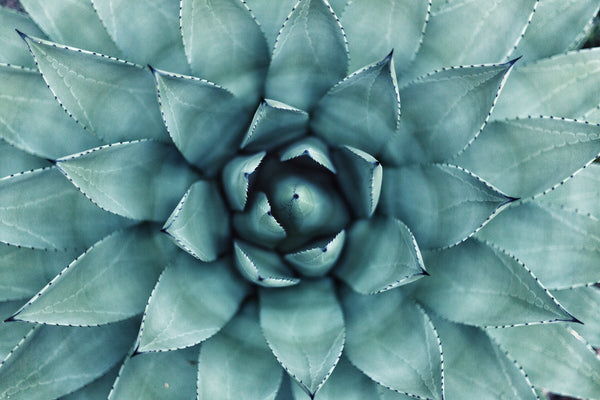
Peering into the heart of an agave rosette. Photo credit by Erol Ahmed
Agaves like cacti are native to the Americas with over 200 species. Maguey, pronounced 'mah gay', is the largest of the agave species growing as tall as 8 feet in a distinctive rosette form with massive bluish to green leaves. Also known falsely as the century plant, maguey can live for nearly 2 decades gathering water along its long, leaf funnels while absorbing carbon dioxide in its stomata (leaf pores) from the cool night desert air. All the water and carbohydrates are stored for one single life ending purpose, a botanical bloom stalk reaching up to 30 feet high.
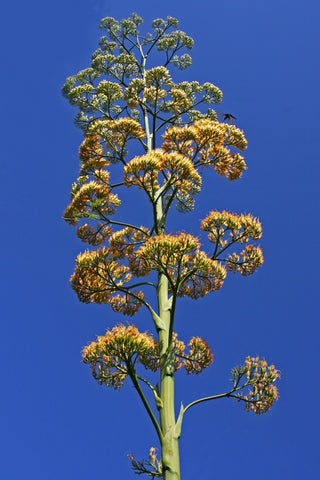
Flowering bloom spike of a maguey. Photo credit by By Thomas Brown (Maguey Flower (Agave americana)), via Wikimedia Commons
Agave was an important resource to many native Americans, however, it was the people of the central valley of Mexico that venerated the wild succulent for its diverse abilities to provide food, fiber, shelter, paper, soap, and a ritual drink known as 'pulque' for the ancient civilization of Teotihuacan, the City of the Gods.

Pulque tasting outside of the Teotihuacan Pyramid site.
A coconut-like sweet fermented drink is collected from the honey water seeping from the cut leaves into the heart of the agave. Nearly a gallon a day of 'aguamiel' or honey water is collected for up to 6 months. In less than 24 hours fermentation begins and that is the sacred ritual drink known as pulque. Scientific studies have shown pulque to be a nutritious libation containing proteins, amino acids, vitamins, minerals, pro and prebiotics. Legend has it that the life-giving blood of the goddess Mayahuel is aguamiel from the heart of the maguey.

Before the agave expends all its energy to flower, the maguey plant is harvested for the honey water. Above is a descriptive image of how early natives removed aguamiel from the heart of the maguey using a long gourd. Photo by Casimiro Castro (1826-1889) [Public domain], via Wikimedia Commons
Before arriving at the pyramids of Teotihuacan 40 km northeast of Mexico City, Cody and I visited a farm where tourists can glimpse the past. We were able to observe how the ancient people utilized the giant agave to build the largest metropolis of the New World rivaling the size of Imperial Rome during the same time period, the first century to the 6th century A.D. The fiber from the maguey leaf was braided into nets or a strong cord for rope. The early peoples of Mesoamerica did not have beasts of burden and had only stone-age tools. The massive pyramids of the site were built on the backs of men with the use of agave fiber.
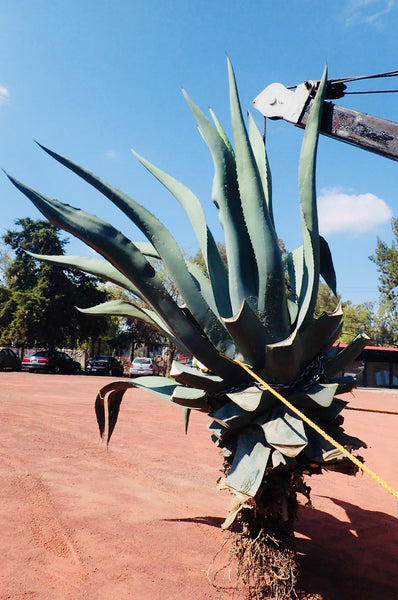
A massive maguey being hauled by a tow truck.
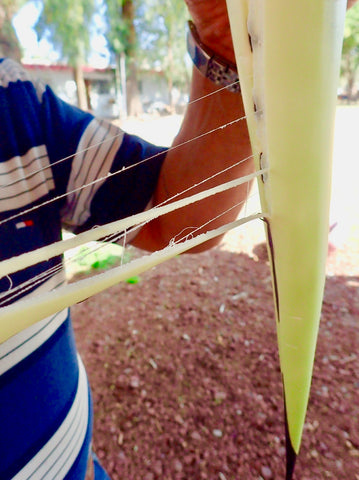
Pulling the fiber fresh from the agave leaf.
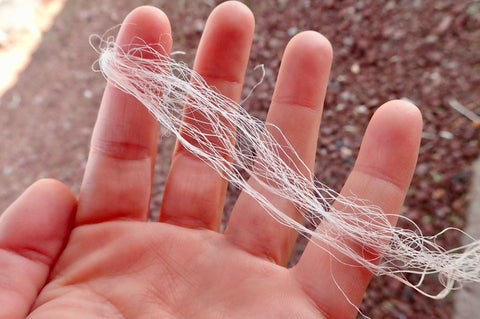
These strands of fiber are used for weaving cloth or braided to make nets or rope.
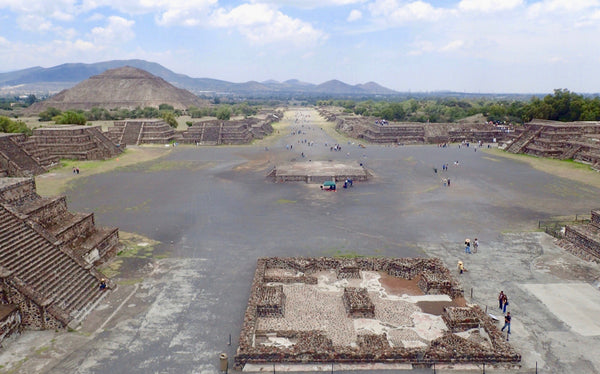
The ancient city of Teotihuacan was over 20 square kilometers laid out on a perfect grid of long avenues from north to south. This ancient metropolis was larger than Imperial Rome (same time period) with a multiethnic population of over 150,000 people from all over Mesoamerica. The fibers of the maguey plant helped to build the massive pyramids, as there were no beasts of burden and only stone-age tools.
When the Aztec's rediscovered the massive pyramid ruins nearly a millennium later, they believed it to be the birthplace of the gods naming the area Teotihuacan or the place of the gods. Archeologists date the construction of the massive pyramid complex to the 1st and 2nd centuries AD. Teotihuacan is the first megacity of the Americas reaching its zenith in the third and fourth century. There are no written historical records or ideograms left behind to tell the story, only artistic murals leave clues. Surprisingly, inscriptions at Maya sites further south in Guatemala and Honduras like Tikal and Copán relate stories of the Teotihuacan people. The cultural diffusion of the Teotihuacan building style and cosmic belief system influenced the early Maya and can be observed in the later pyramid structures, the worship of an underworld and a feathered serpent god, named Kulkulkan to the classic Maya.

The Temple of the Feathered Serpent at Teotihuacan. Similar carvings and reliefs can be found on later Maya pyramids.
The Temple of the Feathered Serpent is situated at the heart of Teotihuacan. Recent excavations have revealed an underground tunnel leading below the center of the temple. Archeologists were hoping to find an important tomb but instead found an underworld filled with pyrite star covered walls with hollowed out channels that were once filled with water. Puzzled at first, then later realizing it may be a metaphor for their creation myth.
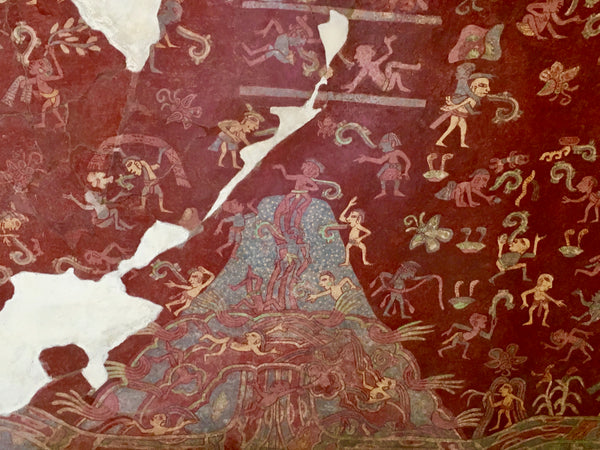
Water flows from the underworld through the mountain creating life. This mural is from the Tepantitla site outside of the main pyramid complex.
Teotihuacan was an important center to the ancient Americas. Artifacts specific to the area, such as green obsidian, are found throughout Mexico, Guatemala, El Salvador, and Honduras. People traveled from all over Mesoamerica to visit the metropolis. Interestingly, there are no defense walls leading archeologists to conclude that the ancient Mesoamericans believed the site to have an important sacred significance, just as the Aztecs believed. Today, Teotihuacan is the most visited archeological site in the Americas. Next time you see an agave, give a nod in honor of the maguey goddess, Mayahuel, whose life-giving blood and fibers helped mankind build an astonishing ancient empire.
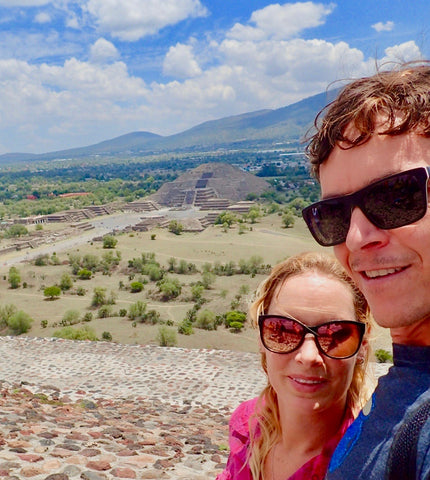
Atop of the Pyramid of the Sun with the Pyramid of the Moon in the background. Over 20 stories high, it was quite a hike up to the top!

These maguey fibers are dyed using plant pigments and then woven into colorful designs for blankets, tablecloths and other items. To see the loom in action visit our YouTube channel, The Botanical Journey or click the link below.
Here are a couple of fascinating resources I found while researching for this article.
The first is a 1958 Ralph Adams production about maguey and Teotihuacan. Only 11 minutes long in a classic Hollywood style and worth watching to see the ancient technique of braiding the fibers into cord and rope at 5:15. Maguey: The Plant of a Thousand Uses
The second is a PBS documentary from 2016 and the uncovering of the tunnel beneath the Temple of the Feathered Serpent. 54 minutes long including the most recent findings and ideas about the ancient metropolis. Teotihuacan's Lost Secrets of the Dead
Last but not least, A minute long video from The Botanical Journey's YouTube channel of a demonstration of the agave fiber loom in action. Agave Fiber Weave

1 comment
Learning of the Maguey in relation to my cultural heritage, this was a fun read! Thanks for writing and sharing.🙏🏽🌿